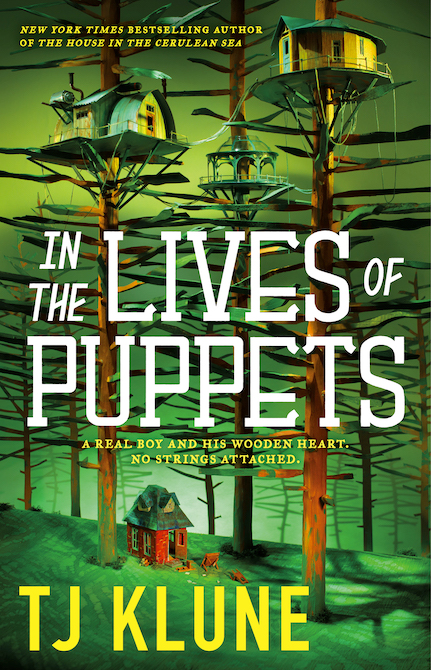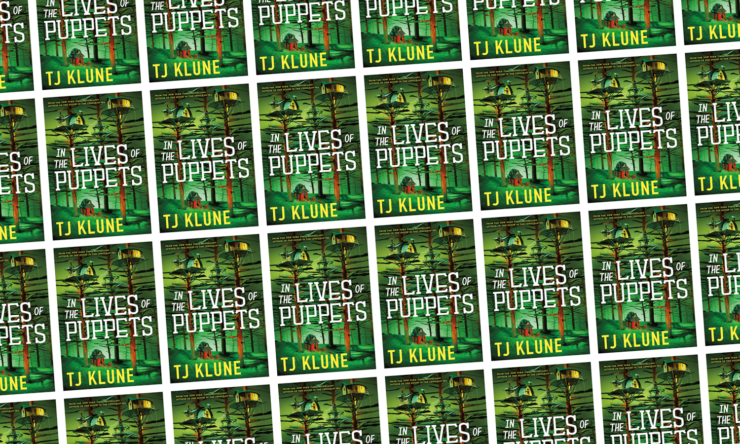Apocalypses don’t have to be just about doom, gloom, and the death of billions. Most good stories set in post-Armageddon scenarios, in fact, are not. And given author TJ Klune’s penchant for telling us tales about love and hope (and the pain that comes with both of these emotions), it’s not surprising that his latest novel, In the Lives of Puppets, is full of more hope, love (and pain) than you might think a story set in a future where robots rule the world has any right to be.
In the Lives of Puppets is loosely inspired by Carlo Collodi’s The Adventures of Pinocchio. There have been notable screen adaptations recently (the recent Disney “live-action” version and the very good one by Guillermo del Toro), but Klune’s book flips the tale by having the story center on a young human man named Victor who lives in the wilderness with a found family of robots, led by his father, the inventor Gio. When he’s 19 years old, Victor restores an android (there are some clear Frankenstein vibes here as well) and gives it some wood-covered appendages to protect the robot’s exposed metal workings. This android names himself Hap, and while he has no memory of his past life, his programming hints at a reality Victor has never experienced firsthand, and indirectly leads to malicious forces finding them, intent on killing those like Victor and forcing Gio to go back to the City of Electric Dreams where he’ll be reprogrammed to do their bidding.
Buy the Book


In the Lives of Puppets
Gio’s kidnapping is devastating for Victor. The android has raised him since he was a baby. Gio is, in every way that matters, Victor’s father. And he loves Victor as such—it is Victor who makes Gio feel less alone in the bowels of the forest and, with the help of a new battery made of wood and metal in his chest that Gio created when Victor was small, the android is able to feel and love (and hurt) in a way he couldn’t before.
(It’s here where it’s worth saying that categorizing In the Lives of Puppets as science fiction or fantasy is an arguable thing. If you’re looking for an answer to that (and you certainly don’t need one to enjoy this book, or any book for that matter), one way to describe In the Lives of Puppets is “sci-fi with fantastical elements.” Another way to describe the novel is “a good book,” if that description is of more interest to you.)
While Victor was growing up, he fixed two other robots that were relegated to the scrap pile long ago—the hilariously abrupt Nurse Ratched, who doles out one-liners that will leave you chortling, and the happily eager Rambo, a Roomba-esque vacuum cleaner who loves nothing more than cleaning up anything and everything. Life is good for Victor and his family as they live in the isolated cocoon of the forest. But the world he lives in is a grim one, where sentient robots have turned against their human creators and decidedly eradicated the species from the planet. Victor has never seen another human in his 19 years alive (or any working robots besides Gio, Ratchet and Rambo, for that matter), and for all he knows he could be the last human left.
But leave it to Klune to tell a story set in one of the grimmest futures those of us made of flesh and bone could imagine and still tell a tale full of love, hope, and heartache. With love comes pain. But it also brings a life worth living. And in In the Lives of Puppets, love and life continue on, even in a world where humans are all but a memory and the robots who remain are far from living in a just society.
Victor (disguised as a robot since his very existence is a death sentence from the androids in charge), Hap, Rambo, and Nurse Ratched face many hardships on their quest to save their father, including a run-in with a robot called the Coachman who wants to display them in a museum(see the aforementioned not about how the book has several nods to Pinocchio). They ultimately, however, make it to the City of Electric Dreams where—with help from the Blue Fairy—they face insurmountable odds to rescue Gio. The fantastical sci-fi plot keeps your brain busy, but through it all the group is also learning who they are and how to hold themselves together, which is relatable no matter what dystopia you live in.
After all, aren’t we just barely cobbled together creatures who experience the terrible joy that comes with loving others? When reading In the Lives of Puppets, I often thought about how a tree grows around a wound it suffers, and how that phenomenon has been used as an analogy for grief. Grief—and the love that it stems from—doesn’t go away; we don’t move on from grief but build around it, making it part of who we are. This analogy came to mind several times when Klune describes Hap’s body, which Victor made whole from wood, metal, and for Hap’s heart, a bit of his human blood mixed in with the wood, the ineffable essence that makes Hap (and Gio, who has the same in his heart) more than the sum of their circuits.
No one goes through life unscathed, and no one isn’t unchanged by those who love us and who we love in return. Love runs through In the Lives of Puppets—parental love, familial love, and also romantic love for Victor, who is asexual, with Hap. The future can be as bleak as a global genocide, but those who survive will do so in no small part because of those they love and those who love them back—the people who fill your heart and keep the ravages of loneliness at bay. In the Lives of Puppets gives you all of this, topped with a healthy dose of humor. The book makes whatever burden that may be weighing you down feel just a little bit lighter or, at least, makes you feel strong enough to carry it.
In the Lives of Puppets is published by Tor Books.
Read an excerpt and a bonus excerpt.
Vanessa Armstrong is a writer with bylines at The LA Times, SYFY WIRE, StarTrek.com and other publications. She lives in Los Angeles with her dog Penny and her husband Jon, and she loves books more than most things. You can find more of her work on her website or follow her on Twitter @vfarmstrong.










